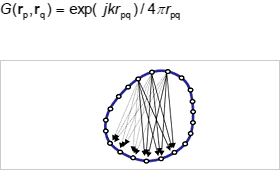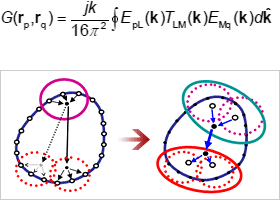WAON's Strength: FMBEM
This section describes the problems encountered with conventional BEM and the features of FMBEM, which realizes the remarkable performance of WAON.
Why FMBEM? Problem of Conventional BEM

Conventional BEM
BEM-based acoustics analysis requires elemental division of the surface of the object subject to analysis. Generally, analysis accuracy increases with the number of elemental divisions. In the case of conventional BEM, however, asymmetrical full matrix calculations are involved, and hence the load incurred for the calculation becomes extremely large. For this reason, there is a need to consider reducing the analysis model size or number of elemental divisions, which often results in numerous restrictions in the analysis model.
In this way, conventional BEM restricts acoustics analysis in terms of elemental divisions and frequency.
Feature of FMBEM

FMBEM
The fast multipole boundary element method (FMBEM) is an analysis method applying the fast multipole algorithm (FMA) to the boundary element method (BEM).
It requires dramatically less memory and fewer calculations than conventional boundary element methods for achieving remarkable performance.
Challenges of conventional BEM:
- Need to reduce calculations
- Need to reduce the size of memory required
FMBEM was adopted for WAON to meet these needs.
Reference Sites
Dr. Tetsuya Sakuma Professor
University of Tokyo – Department of Architecture
Prof. Sakuma is a pioneer applying FMBEM to acoustics analysis.
The WAON FMBEM solver was developed by his research group.





